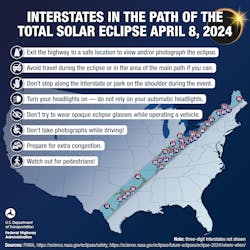There are many things truck drivers and fleet managers need to be aware of daily to avoid slowdowns in the transportation of goods. Add one more thing to that list this weekend: a major astronomical event.
The U.S. will experience a total solar eclipse—the first visible in the U.S. since 2017—this Monday, April 8. The major astronomical event will affect life in the U.S. and the trucking industry in the days leading up to and after the eclipse, as evidenced by a solar eclipse that seven years ago led to highway crashes and injuries.
Here are details of the eclipse and additional information for truck drivers and fleet managers to help them plan accordingly.
Eclipse details: what, when, where, and why
AAA offers driving safety tips for eclipse
- Keep your vehicle’s headlights on.
- Put the sun visor down to block your view of the sun.
- Don’t wear eclipse glasses while driving.
- Don’t try to photograph or video the eclipse while driving.
- Don’t pull over to the side of the road, highway, or interstate to view the eclipse.
- Exit the roadway and park in a safe area away from traffic to view the eclipse.
- Be mindful of pedestrians who may be walking around with their eyes on the sky!
According to NASA, a total solar eclipse occurs when “the moon passes between the sun and Earth, completely blocking the face of the sun. People viewing the eclipse from locations where the moon’s shadow completely covers the sun—known as the path of totality—will experience a total solar eclipse.”
According to the Federal Highway Administration, this eclipse’s path of totality will span 13 U.S. states: Texas, Oklahoma, Arkansas, Missouri, Illinois, Kentucky, Indiana, Ohio, Pennsylvania, New York, Vermont, New Hampshire, and Maine.
According to NASA, the eclipse will first cross into the U.S. from Mexico into Texas around 1:30 p.m. CDT on April 8. It will then exit the U.S. in Maine around 3:30 p.m. EDT.
Trucking restrictions before the eclipse
While the eclipse will occur on a Monday, increased traffic is expected over the weekend in and to the path of totality, according to the FHWA. The last total solar eclipse was August 21, 2017, and created increased traffic near and in the path of totality.
“During the days before and after the 2017 event, people traveled into rural areas near the path of totality,” the FHWA stated in a factsheet over eclipse preparation. “Additionally, increased traffic to remote areas could cause other safety impacts, such as the presence of illegally parked vehicles in unsafe areas (e.g., shoulders or medians), or the increased potential of igniting wildfires in dry areas.”
The FHWA expects similar traffic and safety issues as people travel to view the eclipse.
Tim Menard, CEO of Lyt, a traffic technology company, compares this increase in traffic to that seen around the holiday season.
“There was a significant increase in fatal car crashes in the United States around the time of the 2017 total solar eclipse,” Menard told FleetOwner. “Industry studies found a 31% increase in traffic risks around the time of the eclipse… In absolute terms, this is an average of one extra crash-involved person every 25 minutes and one extra crash fatality every 95 minutes.”
Menard attributes the traffic increase and corresponding safety risks to people being more distracted while driving, driving on unfamiliar roads, and speeding to arrive at a certain location on time.
See also: How the Baltimore bridge collapse impacts trucking
Additionally, multiple states have restricted commercial vehicle traffic over the weekend before the eclipse and on April 8, asking truck drivers not to route through their state. States asking for reduced commercial vehicle traffic include Vermont, Texas, and Arkansas.
While restrictions are being placed on oversized loads, most states only ask truck drivers to avoid traveling in high-traffic areas of their states before, during, and after the eclipse; truck drivers and/or fleets will not be penalized for any actual travel conducted.
Eclipse safety
The upcoming eclipse will bring work and safety challenges to truck drivers, specifically. Menard told FleetOwner that proper planning is critical to keeping drivers safe and productive.
“Today’s truck fleets and other commercial vehicles serve a critical purpose, getting food, goods, raw materials, and medicine from ports and distribution centers out to retail centers where Americans can gain access,” Menard said. “Having clear routes is critical to maintain this infrastructure of commerce and availability. Truck fleets should have a plan ahead of time to identify major traffic corridors that are expected to see the heaviest impact from eclipse on-lookers and other traffic. Proper planning ahead of time will help fleets maintain logistics schedules before, during, and following the eclipse event on April 8.”
About the Author

Jenna Hume
Digital Editor
Digital Editor Jenna Hume joined FleetOwner in November of 2023 and previously worked as a writer in the gaming industry. She has a bachelor of fine arts degree in creative writing from Truman State University and a master of fine arts degree in writing from Lindenwood University. She is currently based in Missouri.


